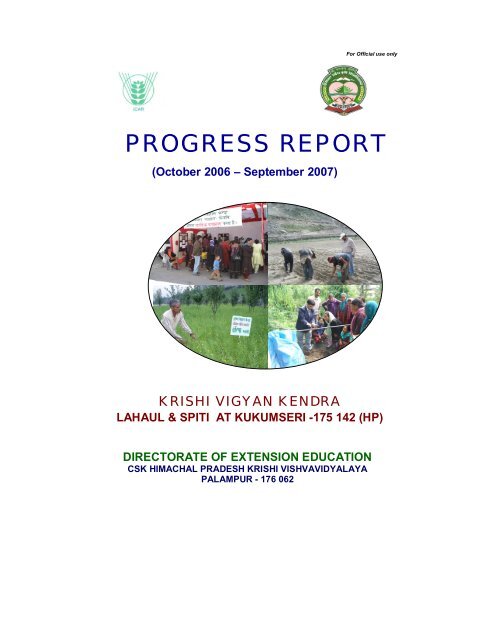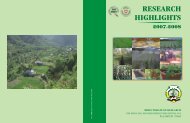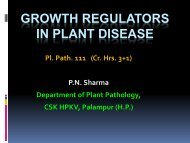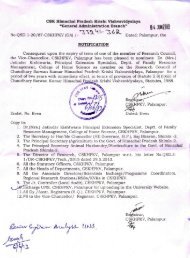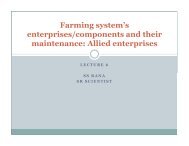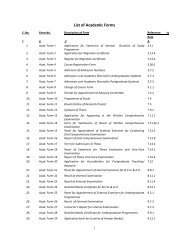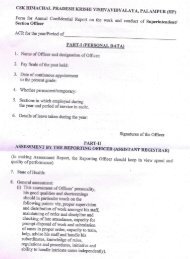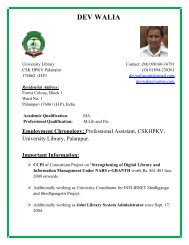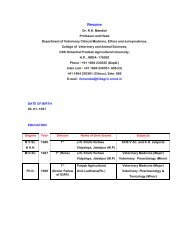Annual Progress Report (October 2006 â September 2007)
Annual Progress Report (October 2006 â September 2007)
Annual Progress Report (October 2006 â September 2007)
You also want an ePaper? Increase the reach of your titles
YUMPU automatically turns print PDFs into web optimized ePapers that Google loves.
For Official use only<br />
PROGRESS REPORT<br />
(<strong>October</strong> <strong>2006</strong> – <strong>September</strong> <strong>2007</strong>)<br />
KRISHI VIGYAN KENDRA<br />
LAHAUL & SPITI AT KUKUMSERI -175 142 (HP)<br />
DIRECTORATE OF EXTENSION EDUCATION<br />
CSK HIMACHAL PRADESH KRISHI VISHVAVIDYALAYA<br />
PALAMPUR - 176 062
CONTENTS<br />
S. No. Title Pages<br />
1-8 Particulars of KVK 1<br />
9 Description of Agro climatic conditions, area & productivity of the 2-5<br />
district<br />
10 Staff position 5<br />
11 Infrastructural Development of demonstration units 6<br />
12 List of equipments available with KVK 6<br />
13 Particular of vehicle/tractor 7<br />
14 Budget 2005-<strong>2006</strong> 7<br />
15 Amount released by the council 8<br />
16 Status of revolving fund 8<br />
17 Utilization of funds (oilseed and pulses) 8<br />
18 Detail of village adopted 9<br />
19 Thrust areas 10<br />
20 Salient recommendations of SAC meeting 10<br />
21 Action taken on QRT Recommendations 11<br />
22 Training achievements 11-12<br />
23 Impact of training programmes 13<br />
24 Extension activities undertaken 13<br />
25 FLDs (oilseed) 14-15<br />
26 FLDs (pulses) 16-17<br />
27 FLDs (other than oilseed & pulses) 17-18<br />
28 On –farm testing 19-20<br />
29 Literature published 21-22<br />
30 Constraints in implementation of programmes 23<br />
31 Feedback 24<br />
32 Farmers reaction 25<br />
33 Linkage with other departments 25<br />
34 Performance of demonstration units 26<br />
35 Performance of KVK infrastructural Farm 26<br />
36 Details of crop wise seed/seedlings of fruit plants produced 26<br />
37 Utilization of hostel facilities 27<br />
38 Staff deputed for trainings/workshops 27<br />
39 Collaborative programmes with other agencies 28-29<br />
40 Empowerment of women 30<br />
41 Detail of additional resources generated 30<br />
42 Innovative technology 31<br />
43 Indigenous Technology 31<br />
44 Training need tools/methodology 31<br />
45 Programmes financed by Govt./other agencies 32<br />
46 Success stories 32<br />
47 Other Information 32<br />
2
PROGRESS REPORT<br />
KRISHI VIGYA KENDRA LAHAUL & SPITI AT KUKUMSERI<br />
(<strong>October</strong> <strong>2006</strong> – <strong>September</strong> <strong>2007</strong>)<br />
1. Name and address of the KVK : Krishi Vigyan Kendra Lahaul & Spiti<br />
at Kukumseri 175 142 (HP)<br />
2. Name of the Host Organization/<br />
Instt. Address<br />
: CSK Himachal Pradesh Krishi<br />
Vishvavidyalaya Palampur-176 062 (HP)<br />
Telegraphic Address: : HIMKRISHI PALAMPUR<br />
Fax No. : 01894 230465<br />
E- mail: : vc@hillagric.ernet.in<br />
3. Name of the Head of the<br />
Organization with Designation<br />
: Dr. Tej Partap<br />
Vice Chancellor<br />
4. Name of the Incharge of the KVK<br />
with Designation<br />
: Dr. Surender Kumar Thakur<br />
Associate Professor (Training)<br />
a) Telegraphic Address : KVK, Kukumseri (L&S)-175142<br />
Telephone with STD Code : 01909-222666 (O), 222210 (fax)<br />
09418253165 (M)<br />
01909-222221 (R)<br />
01894-283232 (Palampur)<br />
b) Residential Address : Scientists Hostel, Udaipur, Lahaul and Spiti-<br />
175 142 (HP)<br />
5. Letter No. and date by which<br />
KVK was sanctioned by ICAR<br />
: F. No.8(1)/2002-AE-II(Pt.) dated Feb.5, 2004<br />
6. Month and year of Inception of<br />
KVK<br />
7. Details of KVK Bank Accounts<br />
(a) With the Host Institute<br />
(b)With the KVK<br />
: April 1, 2004<br />
:<br />
:<br />
:<br />
Name of the Bank Location Acct. No.<br />
SBI Palampur 01070065022<br />
SBI Udaipur 01100055203<br />
1. Total Land with KVK (ha) : 2.60 ha<br />
a) Under Building and Roads : 304 sqm (Farmer’s Hostel)<br />
b) Under Demonstration Units : Yet to be developed<br />
c) Under Crops : 0.60 ha<br />
d) Orchard/Agro Forestry : --<br />
e) Any other (Please specify) : 2.0 ha (undeveloped)<br />
3
9. Brief Description of agro-climatic conditions and farming situations, area and<br />
productivity of main field/ vegetable/fruit crops and livestock of the district<br />
Lahaul and Spiti district (East longitude 76 0 46’29” to 78 0 41’34”, North latitude<br />
31 0 44’57” to 32 0 59’53”) which falls under High Hills Temperate Dry Zone, is the<br />
remotest and most inaccessible area situated in north east part of the state. The area has<br />
most difficult terrain, snow covered mountain peaks and most inhospitable climate. Though<br />
the elevation varies between 2575 to 6700 m a s l, but the cultivable land is up to 4400 m.<br />
The sole access to Lahaul is Rohtang pass (3980 m) and the area remains cut off for most<br />
part of the year due to snowfall on Rohtang. The Spiti region of the district, is a separate<br />
geographical unit, separated from Lahaul by Kunzum pass (4551 m) and is typical Cold<br />
Desert much more difficult with lowest point at 3050 m a s l. Socio-demographic and land<br />
utilization pattern features of the district are as under:<br />
Demographic features of Lahaul-Spiti district of Himachal Pradesh<br />
Particulars<br />
Lahaul-Spiti<br />
Total population 33224<br />
Sex Ratio/1000 male 802<br />
Density per sq. km. 2<br />
Literacy rate (%)<br />
Male<br />
Female<br />
73.17<br />
82.76<br />
60.94<br />
Main workers (Total Nos.)<br />
Cultivators<br />
Agricultural Labourers<br />
Household industries<br />
Other workers<br />
Total geographical area( 000 ha)<br />
By professional survey<br />
By village papers<br />
21088<br />
11160<br />
399<br />
136<br />
9453<br />
1383.5<br />
911.2<br />
Land Utilization statistics of Lahaul-Spiti district of Himachal Pradesh (000 ha)<br />
Particulars<br />
Total<br />
Total geographical area 911.1<br />
Forests 135.4<br />
Barren and uncultivable land 415.8<br />
Land put to non agricultural uses 135.7<br />
Culturable waste land 0.6<br />
Permanent pastures and other grasslands 220.14<br />
Land under miscellaneous trees etc. 0.10<br />
Fallow land 0.4<br />
Net sown area 3.291<br />
Area sown more than once 0.173<br />
Net irrigated area as % to net area sown 100%<br />
Total cropped area 3.464<br />
4
Climate and soil<br />
Due to variation in geographical location, altitude, topography etc. there is great<br />
diversity in climate. In general, the climate is extremely cold and heavy snowfall occurs<br />
during winter and the temperature remains several degrees below zero. Winter season<br />
extends from November to March and the district remains cut off from rest of the world<br />
during this period. The spring-summer seasons are from April to <strong>September</strong> and monthly<br />
maximum and minimum temperature varies between 12-24°C and 4.7-17°C, respectively.<br />
The rainfall also varies from one location to another (90-470.3 mm) with average rainfall of<br />
250 mm per annum. The soil of the district is sandy to sandy loam in texture, neutral in<br />
reaction, and low to medium in fertility.<br />
Crops and cropping pattern<br />
The agriculture in the district has virtually kharif/summer as full cropping season.<br />
The area is famous for production of off-season pea, and seed potato. Of late due to<br />
marketing problem area under hops has decreased tremendously during the last five years.<br />
Other crops grown in the area are barley, wheat, temperate vegetables, maize and rajmash.<br />
In Spiti, the farmers also grow peas and take it as pulse. In general, mono cropping is<br />
followed and both kharif and rabi crops are grown simultaneously from April-<strong>October</strong>.<br />
However, in Udaipur sub-division of Lahaul, double cropping system viz. pea-buckwheat,<br />
pea- mustard/toria, and peas-oats is followed. The climate is suitable for seed production of<br />
red clover and other temperate grasses and vegetables. All crops are raised under irrigated<br />
conditions through 'Kuhls' in which natural gravitational water flows. The 'Kuhls' are fed by<br />
melting snow of glaciers, snow fields and avalanches. The area under different crops in<br />
Lahaul & Spiti district is presented below:<br />
Area under different crops in Lahaul & Spiti district of HP<br />
S. No. Crop Area (ha)<br />
1 Pea 1560<br />
2. Potato 755<br />
3. Barley 608<br />
4. Wheat 75<br />
5. Vegetables 51<br />
6. Maize 46<br />
7. Hops 4<br />
8. Fruits 312<br />
5
Agro forestry and pasture lands<br />
Fodder trees like willow (Salix alba) and Robinia (Robinia pseudoacasia) are<br />
grown by the farmers on sloppy lands near the village on community basis.Farmers also<br />
raise willow and seabuckthorn (Hippophae spp.) on field bunds. Willow is the major<br />
component of this system which is relied upon for the supply of fodder, fuel and timber. In<br />
Lahaul, farmers have pastures where grasslands are irrigated to get luxuriant growth of<br />
grasses.<br />
Farmers of the valley are also growing medicinal plants like kuth and manu in their<br />
cultivated fields. Some farmers collect medicinal and aromatic plants like Karu, Patish,<br />
Panja, Bankakri, Chora and Kalazira from the high altitude areas of the valley.<br />
Animal husbandry<br />
Animal husbandry remains an indispensable sector in agriculture of Lahaul and<br />
Spiti. Inspite of adverse climate and scarce fodder very good cross breeds of Jersey cows<br />
are found with every house hold. Good cross breeds of sheep are also available in the<br />
valley. There are some goats, and poultry farming at backyard level is also practiced. Other<br />
than that a traditional cross between yak and cow called “Churu/Churi” is also found.<br />
Female (Churi) is used as milk animal and male (Churu) is a very efficient draught animal<br />
in the harsh climate and difficult terrain.<br />
Number of different categories of animals in Lahaul and Spiti<br />
Sr. No Category Population<br />
(Nos.)<br />
1 Cattle 13301<br />
2 Yak 1068<br />
3 Sheep 41449<br />
4 Goats 10568<br />
5 Horses & Ponies 1175<br />
6 Mules 52<br />
7 Donkeys 2290<br />
Total 69903<br />
6
Horticulture<br />
The high hills temperate dry zone of Himachal Pradesh is known for the production<br />
of export quality apple, drying type of apricot and almonds. Area under fruit trees has<br />
reached to 312 ha in last few years. Among this the apple (285 ha) is the leading fruit crop<br />
being grown in Lahaul & Spiti and it is becoming another commercial crop of the district.<br />
Although, almond, walnut and drying types of apricots are the other potential fruit crops<br />
which can be grown successfully.<br />
10. Staff Position (as on 30 th <strong>September</strong>, <strong>2007</strong>)<br />
S. No. Name and<br />
Designation as<br />
per sanctioned<br />
strength<br />
1. Dr. S K Thakur<br />
Associate<br />
Professor<br />
(Training)<br />
2. Dr. Pardeep<br />
Kumar<br />
Assistant<br />
Extension<br />
Specialist<br />
3. Dr. R K Rana<br />
Assistant<br />
Extension<br />
Specialist<br />
4. Dr. P K Sharma<br />
Assistant<br />
Extension<br />
Specialist<br />
5. Dr. Anjana Patial<br />
Assistant<br />
Extension<br />
Specialist<br />
6. Dr. Dinesh Krofa<br />
Assistant<br />
Extension<br />
Specialist<br />
7. Sh. B L Dhadwal<br />
Superintendent<br />
8. Sh. Jagdish<br />
Kumar<br />
Technical<br />
Assistant<br />
9. Dr. Jagdish<br />
Chand<br />
Technical<br />
Assistant<br />
Discipline<br />
Pay scale*<br />
with present<br />
basic pay<br />
Soil Science 12000-18000<br />
(12420)<br />
Plant<br />
Pathology<br />
8000-13500<br />
(9375)<br />
Pomology 8000-13500<br />
(9375)<br />
Agroforestry/<br />
Forestry<br />
8000-13500<br />
(9375)<br />
Entomology 8000-13500<br />
(9375)<br />
Veterinary/<br />
Animal<br />
Sciences<br />
8000-13500<br />
(8275)<br />
-- 6410-10980<br />
(11320)<br />
Agriculture 5000-8100<br />
(7220)<br />
Agronomy 5000-8100<br />
(5320)<br />
Date of<br />
joining*<br />
Total<br />
emoluments<br />
Category<br />
SC/ST/<br />
OBC/<br />
Others<br />
3.5.06 25701 Others<br />
7.4.06 19510 SC<br />
10.4.06 19510 Others<br />
10.4.06 19510 Others<br />
10.4.06 19510 ST<br />
10.4.06 19870 ST<br />
31.3.05 23773 Others<br />
11.8.05 14720 Others<br />
20.04.07 11198 SC<br />
7
10. Ms Ruchi<br />
Kaundal<br />
Technical<br />
Assistant<br />
11. Sh Randhir Singh<br />
Chowkidar<br />
12. Sh Pawan Gularia<br />
Peon<br />
Home<br />
Science<br />
13. Sh Ashok Kumar<br />
Driver<br />
14. Sh Sikandar<br />
Kumar<br />
Driver<br />
* For those staff who are in position<br />
5000-8100<br />
(5320)<br />
-- 2520-4140<br />
( Initial Start<br />
2620)<br />
-- 2620-4120<br />
( Initial Start<br />
2620)<br />
-- 3330-6200 +<br />
700 SA<br />
-- 3330-6200 +<br />
700 SA<br />
16.07.07 11578 OBC<br />
18.6.07 6361 Other<br />
18.6.07 6361 Other<br />
20.7.07 8188 OBC<br />
20.7.07 8188 OBC<br />
11. Infrastructural Development including demonstration units available with the<br />
KVK<br />
Name of building<br />
Completed<br />
(plinth area in<br />
sqm.)<br />
Stage<br />
Incomplete<br />
(plinth area<br />
in sqm.)<br />
Cost (lakhs)<br />
Estimate<br />
(for new<br />
building)<br />
Source<br />
of fund<br />
Administrative Building -- -- 124.73 ICAR<br />
Farmer’s Hostel 304.28 -- -- ICAR<br />
Staff Quarters (6) -- -- 91.88 ICAR<br />
Demonstration units -- -- 73.52 ICAR<br />
Any other<br />
Land development,<br />
-- -- 84.11 ICAR<br />
polyhouse, threshing floor &<br />
approach road to KVK<br />
Total -- -- 374.24 --<br />
12 List of equipments available with the KVK (Item above Rs. 5000)<br />
Sr.No. Name of equipment Cost (Rs) Date of Condition<br />
purchase<br />
1 Over head projector 8,111 30.3.1999 Good<br />
2 Photocopier 84,201 31.3.1999 Unserviceable<br />
3 Portable Generator 43,424 28.3.2000 Good<br />
4 Tiller 9-Tyne 13,343 5.5.2002 Good<br />
5 Computer system 44,630 28.3.2003 Good<br />
6 PA system 23,760 27.12.2003 Good<br />
7 UPS 6,950 9.1.2002 Not in working order<br />
8 HP laser jet printer 15,225 9.1.2003 Good<br />
9 Scanner 9,600 27.3.2003 Good<br />
10 LCD 99,405 29.3.<strong>2007</strong> Good<br />
8
13. Particulars of Vehicles i.e. Mini bus, Jeep, Scooter, Motor Cycle and Tractor<br />
Type of<br />
Vehicle<br />
1.Tractor<br />
M-F<br />
Year of<br />
Purchase<br />
Opening<br />
Reading<br />
Closing<br />
Reading<br />
Distance<br />
covered<br />
during the<br />
year<br />
Total<br />
distance<br />
covered so<br />
far<br />
Present<br />
condition<br />
of the<br />
vehicle<br />
7.2.2002 545 hr 698 hrs 153 hrs 698 hrs Good<br />
14. Budget for the financial year <strong>2006</strong>-07<br />
(Rs. in lakhs)<br />
S. Particulars Sanctioned Released Expenditure Balance as<br />
No.<br />
on 1.4.07<br />
A Recurring Items<br />
1 Pay and allowance 18.00 18.00 17.61511 0.38189<br />
2 Traveling allowance 0.40 0.40 0.39956 0.00044<br />
3 Contingencies 3.25 3.25 3.23826 0.01174<br />
(a) Stationery, telephone,<br />
-- -- -- --<br />
postage and other<br />
expenditure on office<br />
running<br />
(b) POLs, repair of vehicles, -- -- -- --<br />
tractor and equipments<br />
(c) Vocational training -- -- -- --<br />
(i) Meals/refreshment for<br />
-- -- -- -<br />
trainees (ceiling up to Rs. 40<br />
per day per trainees be<br />
maintained)<br />
(ii) Training Materials<br />
-- -- -- --<br />
(poster, charts,<br />
demonstration materials<br />
including chemicals etc.<br />
required for conducting<br />
training)<br />
(iii) FLD other than oilseeds -- -- -- --<br />
and pulses (minimum of 30<br />
demonstrations in a year)<br />
(iv) On-Farm Testing (on<br />
-- -- -- --<br />
need based, location specific<br />
and newly generated<br />
information in the major<br />
production system of the<br />
area)<br />
(v) Training of extension<br />
-- -- -- --<br />
functionaries<br />
(vi) Library maintenance 0.10 0.10 0.09426 0.00574<br />
and adding new books<br />
(vii) Maintenance of<br />
-- -- -- --<br />
building<br />
Total (A)<br />
B Non recurring items<br />
1 Works (main -- -- -- --<br />
9
uilding/farmer hostel/<br />
Residence/demonstration<br />
etc.<br />
2 Equipment, furniture &<br />
-- -- -- --<br />
furnishing<br />
3 Tractor /farm implements -- -- -- --<br />
4 Purchase /replacement of -- -- -- --<br />
vehicles<br />
5 Library --<br />
6 Others -- -- -- --<br />
Total (B)<br />
C Revolving fund<br />
Grand total (A+B+C) 21.75 21.75 21.34719 0.40281<br />
15. Amount released by the Council : Rs. 21.75 lakhs<br />
16. Status of revolving fund (Rs. In Lakh) : For three years<br />
Date of sanction/release by the Council : 01.04.2004<br />
Amount released by the Council<br />
: 1.00 lakh<br />
Amount refunded to the council : Nil<br />
Year<br />
Opening<br />
Expected income<br />
balance Interest Farm income<br />
Net balance in<br />
hand as on 1 st<br />
April of each<br />
year<br />
2004-05 -- -- -- --<br />
2005-06 1.00 0.02663 0.020 1.04663<br />
<strong>2006</strong>-07 1.04663 0.03720 0.030 1.11375<br />
17. Utilization of Funds under FLD on Oilseeds/Pulses (Units in Rs.)<br />
Item<br />
Sanctioned by<br />
ZC<br />
Released by the<br />
Host Institution<br />
Expenditure Unspent<br />
balance on<br />
Kharif Rabi Kharif Rabi Kharif Rabi 1 st April<br />
Oilseeds<br />
Inputs 7000 -- 7000 -- 6494 -- 506<br />
Extension 1000 -- 1000 -- 1000 -- --<br />
activities<br />
TA/DA/POL etc. 400 -- 400 -- 380 -- 20<br />
Contingencies 600 -- 600 -- 600 -- --<br />
Total 9000 -- 9000 -- 8474 -- 526<br />
Pulses<br />
Inputs 18760 -- 18760 -- 14134 -- 4626<br />
Extension 2680 -- 2680 -- 2680 -- --<br />
activities<br />
TA/DA/POL etc. 880 -- 880 -- 825 -- 55<br />
Contingencies 1800 -- 1800 -- 1800 -- --<br />
Total 24120 -- 24120 -- 19439 -- 4681<br />
10
18. Details of villages adopted/farm families selected and survey conducted<br />
a) No. of villages adopted : 7<br />
b) No. of farm families selected : 34<br />
c) Survey/PRA conducted :<br />
During PRA the cropping pattern of the sample households revealed that<br />
cash crops i.e. seed potato and pea dominated all other crops by contributing 70 to 72 per<br />
cent to the total cropped area. The rest of the 28-30 per cent of the area was being occupied<br />
by other crops such as wheat, barley, rajmash, vegetables, buckwheat, kuth, hops, fruits and<br />
pasture/ghasnis. Leaving aside the commercial crop rest all were being grown in small<br />
areas for their own domestic use. Through triangulation the consensus developed on<br />
various problems that needed external help for solution were; high yielding disease resistant<br />
varieties of pea and potato, lack of knowledge on control of weeds, insect-pest and diseases,<br />
substitute or alternative for cash crops of pea and potato, declining productivity of pea and<br />
potato, costly inputs, transportation and marketing. Based on the feedback received during<br />
PRA, the action plan of KVK was formulated in which OFT, demonstration and training<br />
programmes concerning the problems so revealed were conducted. The KVK started search<br />
for alternative cash crops such as vegetables and fruits besides introduction of new high<br />
yielding disease resistant varieties of pea and potato in addition to training and<br />
demonstration on full package of practices for both the crops.<br />
The survey revealed that during <strong>2006</strong>, 100 per cent plant infestation in potato by<br />
cutworm was observed in many fields of the villages in Madgran. It was followed by<br />
infestation in pea and cabbage. However, during <strong>2007</strong>, cutworm incidence in pea and potato<br />
was less than previous year.<br />
The survey on fruit crops revealed that many of the orchards in the valley are<br />
showing deficiency of micro nutrients especially Zn and B as has been visually identified<br />
through their symptoms. The other problem identified through survey was sunburn/canker<br />
problem in apple plants due to poor management practices and poor quality planting<br />
material. The finding will be utilized in planning for the next year. In the next year the<br />
survey on the soil and leaf nutrient status will be conducted in the district. The Kendra has<br />
already started the nursery work and has submitted 2 projects on nursery development<br />
facility for propagation of quality planting materials.<br />
11
19. Thrust areas identified through PRA or any other method:<br />
• Package & practices for production of disease free seed of pea and potato<br />
• Development of high yielding and disease resistant(root rot/wilt complex and<br />
powdery mildew) cultivars of pea<br />
• Alternate commercial crop for pea<br />
• Nursery production of apple to increase the area under apple<br />
• Introduction of improved fodder and grass species<br />
• Popularization of balanced feeds, UMB and supplementary rations for milch animals<br />
• Development of IPM practices for the important insect pests and diseases<br />
• Protected vegetable cultivation<br />
• Post-harvest technology for seabuckthorn, vegetables and fruits<br />
20. Scientific Advisory Committee Meeting: (Yet to be convened)<br />
S. No. Salient recommendations Action taken Remarks<br />
1. Their is urgent need for the The Kendra has laid out 2 nd SAC<br />
improvement of pastures and Demonstration on improved Meeting<br />
grass lands with improved grasses at Madgran, Charu and<br />
grasses.<br />
Namo.<br />
2. Emphasis on Scientific<br />
cultivation of Seabuckthorn.<br />
3. The supply of quality planting<br />
materials of improved varieties of<br />
apple to the farmers and trainings<br />
on training and pruning of apple<br />
trees.<br />
4. Problem of drying of willow<br />
trees.<br />
The Kendra is organizing training<br />
camps on scientific cultivation of<br />
seabuckthorn. The visiting farmers<br />
to Kendra are also being shown<br />
the improved and exotic lines of<br />
seabuckthorn.<br />
The Kendra has started the nursery<br />
production work this year and in<br />
the coming years the farmers will<br />
get the quality planting materials.<br />
Besides this the two projects has<br />
been submitted on development of<br />
facility for the quality nursery<br />
production of fruit crops for<br />
funding.<br />
Regarding this problem, recently a<br />
team of expert from Dr Y S<br />
Parmar University of Horticulture<br />
and Forestry, Solan had surveyed<br />
the valley to find out the possible<br />
reason. The report of the same is<br />
awaited.<br />
12
21. Action taken on QRT Recommendations: NA<br />
22. Training Achievements (including sponsored training)<br />
The details of on- campus, off-campus and sponsored trainings are given separately<br />
as per format given below:<br />
Off-campus<br />
Discipline<br />
No. of<br />
courses<br />
No. of participants No of SC/ST<br />
participants<br />
M F Total M F Total<br />
Practicing Farmers/Farm Women<br />
1. Agriculture Extension -- -- -- -- -- -- --<br />
2. Agriculture<br />
-- -- -- -- -- -- --<br />
Engineering<br />
3. Agro Forestry 7 -- -- -- 82 73 155<br />
4. LPM 10 -- -- -- 128 70 198<br />
5. Crop Production 1 -- -- -- 15 6 21<br />
6. Fisheries -- -- -- -- -- -- --<br />
7. Home Science -- -- -- -- -- -- --<br />
8. Horticulture 7 -- -- -- 124 29 153<br />
9. Plant Protection 17 -- -- -- 215 150 365<br />
10. Soil Fertility and 4 -- -- -- 59 23 82<br />
Management<br />
11. Others* -- -- -- -- -- -- --<br />
Total 46 -- -- -- 623 351 974<br />
*Others may include the courses on mushroom production, apiculture, rural craft and<br />
sericulture or any other discipline but it may be specified.<br />
On-campus<br />
Discipline<br />
Rural youths, Practicing Farmers/Farm Women<br />
No. of No. of participants SC/ST participants<br />
courses M F Total M F Total<br />
1. Agriculture Extension -- -- -- -- -- -- --<br />
2. Agriculture<br />
Engineering<br />
-- -- -- -- -- -- --<br />
3. Apiculture -- -- -- -- -- -- --<br />
4. LPM -- -- -- -- -- -- --<br />
5. Crop Production -- -- -- -- -- -- --<br />
6. Fodder management/<br />
Agroforestry<br />
-- -- -- --<br />
7. Home Science -- -- -- -- -- -- --<br />
8. Horticulture 2 -- -- -- 21 17 38<br />
13
9. Plant Protection 4 -- -- -- 52 15 67<br />
10.Vegetable Production -- -- -- -- -- -- --<br />
11. Others*<br />
Vermicomposting 2 -- -- -- 22 23 45<br />
Organic farming 1 -- -- -- 17 7 24<br />
Total 9 -- -- -- 112 62 174<br />
*Others may include the courses on biofertilizers, biopesticide, medicinal plant,<br />
sericulture and soil fertility (specify).<br />
Discipline<br />
Extension Functionaries<br />
No. of No. of participants SC/ST participants<br />
courses M F Total M F Total<br />
Agriculture Extension -- -- -- -- -- -- --<br />
Agriculture Engineering -- -- -- -- -- -- --<br />
Agro-forestry 1 -- -- -- 18 0 18<br />
LPM -- -- -- -- -- -- --<br />
Crop Production -- -- -- -- -- -- --<br />
Fisheries -- -- -- -- -- -- --<br />
Home Science -- -- -- -- -- -- --<br />
Horticulture 1 -- -- -- 13 -- 13<br />
Plant Protection 2 -- -- -- 23 -- 23<br />
Soil Fertility 1 -- -- -- 5 0 5<br />
Others* -- -- -- -- -- -- --<br />
Total 5 -- -- -- 61 0 61<br />
*Others may include the courses on Agri-business apiculture, medicinal plant,<br />
mushroom production, rural crafts and sericulture (specify).<br />
Sponsored Training Programmes<br />
Title of Training Discipline Month Duration (days) No. of total<br />
No. of SC/ST<br />
Sponsoring agency<br />
participants<br />
participants<br />
M F Total M F Total<br />
Agricultural camp Multi disciplinary June 1 day -- -- -- 12 51 63 Department of<br />
Agriculture<br />
Integrated agriculture<br />
technology for<br />
sustainable crop<br />
production in Lahaul<br />
& Spiti<br />
Multi disciplinary July 2 days -- -- -- 4 23 27 Department of<br />
Agriculture<br />
M- Male; F- Female<br />
14
23. Impact of Training Programmes on Beneficiaries:<br />
Name of Specific<br />
Technology/ Skill<br />
transferred<br />
Seed treatment with<br />
Bavistin in pea<br />
Cut worm<br />
management in<br />
potato<br />
No. of<br />
trainees<br />
% of<br />
adoption<br />
Change in income (Rs.)<br />
Before After training<br />
training (per ha)<br />
(per ha)<br />
Impact indicator<br />
115 64 52,800 71,500 Increase in<br />
productivity and<br />
income<br />
50 56 1,32,700 1,49,360 --do--<br />
Vermi-composting 30 27 --- -- Used at their own<br />
farm<br />
Cultivation of toria<br />
as a second crop<br />
65 70 12,400 16,400 Increased yield over<br />
local variety Yungar<br />
24. Extension Activities undertaken<br />
Sr.No. Activities No Date No. of beneficiaries No. of Extension Remarks<br />
Functionaries<br />
M F Total M F Total<br />
1. Kisan Mela -- -- -- -- -- -- -- -- --<br />
2. Field days<br />
with date,<br />
crop wise<br />
details<br />
i) Pea<br />
ii) Potato<br />
iii) Rajmash<br />
iv) Toria<br />
1<br />
1<br />
1<br />
1<br />
1<br />
21.6.<strong>2007</strong><br />
4.9.<strong>2007</strong><br />
7.09.<strong>2007</strong><br />
18.9.<strong>2007</strong><br />
21<br />
29<br />
20<br />
9<br />
57<br />
7<br />
10<br />
13<br />
78<br />
36<br />
30<br />
22<br />
--<br />
--<br />
--<br />
--<br />
--<br />
--<br />
--<br />
--<br />
--<br />
--<br />
--<br />
--<br />
--<br />
--<br />
--<br />
--<br />
3. Kisan goshti 10 358 -- -- -- --<br />
4. Radio Talk -- -- -- -- -- -- -- -- --<br />
5. TV Show 2<br />
4<br />
1.3.<strong>2007</strong><br />
7.8.<strong>2007</strong><br />
--<br />
--<br />
--<br />
--<br />
--<br />
--<br />
--<br />
--<br />
--<br />
--<br />
--<br />
--<br />
--<br />
--<br />
6. Film Show 22 -- -- -- -- -- -- -- --<br />
7. Exhibition 1 14 to 16<br />
August<br />
-- -- >1100 -- -- -- Bagged<br />
FIRST<br />
PRIZE<br />
8. Newspaper 13 -- -- -- -- -- -- -- --<br />
coverage<br />
9. Advisory 66 -- -- -- 253 -- -- -- --<br />
Services<br />
10. Ex-trainees 1 9.6.07 12 51 63 -- -- -- --<br />
Sammelan<br />
11. World Food -- -- -- -- -- -- -- -- --<br />
day<br />
12. Women in -- -- -- -- -- -- -- -- --<br />
Agriculture<br />
13. Any other 1 21.11.06 50 30 80 -- -- -- --<br />
(specify)<br />
Science day<br />
• Participants invariably be specified in number.<br />
• Enclose photocopies of newspaper coverage with title in English<br />
15
News paper coverage titles<br />
i) iksaanaaoM kao ide KotI ko gaur.<br />
ii) ispit GaaTI maoM jaaO kI fsala Ktro maoM – kRiYa<br />
iva&ainakaoM nao daOra kr jaanaI isqait.<br />
iii) iSaivar maoM vana kma-caairyaaoM kao idyaa<br />
AaOYaQaIya &ana.<br />
iv) laahaOla maoM calaica~ idKakr jaaga$k ike<br />
iksaana.<br />
v) iksaanaaoM kao dI na[- tkinakaoM kI jaanakarI.<br />
vi) iksaanaaoM kao taoiryaa kI KotI krnao kI salaah.<br />
vii) laahaOla maoM AaOYaQaIya paOQaaoM pr kaya-<br />
Saalaa.<br />
viii) svasqa samaaja ko inamaa-Na kao hao phla -<br />
razaOr<br />
ix) saimait kI vak-Saap kolaaMga maoM 27 sao.<br />
x) rsaayainak riht baImaairyaaoM ko p`banQana pr<br />
iSavar.<br />
xi) jaaOM mao kro iTlT ka iCD,kava.<br />
xii) tIna idvasaIya rajya strIya janajaatIya ]
Crops<br />
Area (ha)<br />
No. of Farmers/Demonstration<br />
Proposed Actual SC/ST others Total<br />
Remarks<br />
Toria - 1.0 8 - 8 --<br />
Mustard 4.0 4.0 48 - 48<br />
Total 4.0 5.0 56 - 56 --<br />
NB: Attach a few photographs with title at the back of photographs with pencil<br />
B) Performance of Frontline Demonstration (FLD) on Oilseeds<br />
Crop : Toria/Mustard<br />
Season : Kharif<br />
Sowing Date : July, <strong>2006</strong><br />
Harvesting Date : Sept/Oct.<strong>2006</strong><br />
Farming situation : Irrigated<br />
Soil type : Sandy loam<br />
District : Lahaul and Spiti<br />
Agroclimatic Zone : High Hills Temperate Dry<br />
Previous year cropping pattern : Pea-Mustard<br />
Status of NPK : Lab. yet to be established<br />
Seasonal Rainfall (mm) : Scanty<br />
Variety No. of Area<br />
Yield (q/ha)<br />
Increase Cost of additional cash Gross Net B:C ratio<br />
farmers (ha)<br />
in yield inputs (Rs/ha)<br />
returns returns<br />
Demonstration Local (%) Demonstration Local<br />
Highest Lowest Avg. check<br />
check<br />
Bhawani 8 1.0 9.5 7.4 8.2 6.20 32.25 2266 1748 16400 3785 0.30<br />
KBS-3 48 4.0 10.5 8.2 9.3 6.2 46.77 2266 1748 21390 4809 0.29<br />
(C) Analytical review of component of demonstrations<br />
Crop Season Farming<br />
situation<br />
Component<br />
Toria Kharif Irrigated Seed (Bhawani) +Fertilizer<br />
(NPK)<br />
Mustard Kharif Irrigated Seed (Bhawani) +Fertilizer<br />
(NPK)<br />
Average<br />
yield<br />
(q/ha)<br />
Local check<br />
(q/ha)<br />
8.2 6.2 32.25<br />
9.3 6.2 46.77<br />
% increase in<br />
productivity over<br />
local check<br />
(D) Technical Feedback<br />
1. Short duration, high yielding, variety of mustard/toria need to be developed, to<br />
fit in the double cropping system after pea.<br />
(E) Farmers reactions<br />
1. Farmers are growing local mustard as a second crop after pea or barley and<br />
apply only urea fertilizer. With the introduction of toria (Bhawani) and using<br />
recommended fertilizers, yield has been increased by 30-47% and the farmers<br />
are satisfied with its performance.<br />
(F) Extension and training activities<br />
17
S. No. Activity No. of activities<br />
organized<br />
No. of participants<br />
Remarks<br />
1. Field Days 1 31 --<br />
2. Farmers Training 2 59 --<br />
3. Kisan Gosthi 3 76 --<br />
26. (A) Front line Demonstrations (Give crop wise details)-Pulses<br />
Crop:<br />
Rajmash<br />
Season:<br />
Kharif<br />
Farming Situation (Rainfed/Irrigated): Irrigated<br />
Year: <strong>2006</strong><br />
Crops<br />
Area (ha)<br />
No. of Farmers/Demonstration<br />
Proposed Actual SC/ST others Total<br />
Remarks<br />
Rajmash 6 2.0 30 -- 30 --<br />
Field peas 2.0 -- -- -- -- --<br />
Total 8.0 2.0 30 -- 30 --<br />
NB: Attach a few photographs with title at the back of photographs with pencil<br />
(B) Performance of Frontline Demonstration (FLD) on Pulses<br />
Crop : Rajmash<br />
Season : Kharif<br />
Sowing Date : May, <strong>2006</strong><br />
Harvesting Date : Sept/Oct.<strong>2006</strong><br />
Farming situation : Irrigated<br />
Soil type : Sandy loam<br />
District : Lahaul and Spiti<br />
Agro climatic zone : High Hills Temperate Dry<br />
Previous year cropping pattern : Pea<br />
Status of NPK : Lab. yet to be established<br />
Seasonal Rainfall (mm) : Scanty<br />
Variety<br />
No. of<br />
farmers<br />
Area<br />
(ha)<br />
Yield (q/ha)<br />
Increase<br />
in yield<br />
(%)<br />
Cost of additional cash<br />
inputs<br />
(Rs/ha)<br />
Demonstration Local<br />
check<br />
Gross<br />
returns<br />
Net<br />
returns<br />
Demonstration<br />
Local<br />
Highest Lowest Avg. check<br />
Him -1 12 0.64 21.4 15.9 18.8 12.5 50.4 10714 5250 65800 42631 1.84<br />
Kanchan 18 1.36 20.9 14.5 17.0 12.5 36.0 10714 5250 59500 36348 1.57<br />
(C) Analytical review of component of demonstrations<br />
B: C<br />
ratio<br />
Crop Season Farming Component<br />
situation<br />
Rajmash Kharif Irrigated Seed<br />
Average yield<br />
(q/ha)<br />
Local check (q/ha)<br />
% increase in productivity over local check<br />
Him-1 18.8 12.5 50.4<br />
Kanchan 17.0 12.5 36.0<br />
(D) Technical Feedback<br />
18
1. Availability of seeds of improved varieties of rajmash is insufficient. There is urgent<br />
need to produce quality seeds in large amounts.<br />
(E) Farmers reactions<br />
1. Farmers are appreciative of the improved varieties of rajmash which yields higher<br />
over local mixture.<br />
(F) Extension and training activities<br />
Sr No. Activity No. of<br />
activities<br />
organized<br />
No. of<br />
participants<br />
1. Field Days 1 32 --<br />
2. Farmers Training 4 88 --<br />
3. Kisan goshthi 1 31 --<br />
Remarks<br />
27. Front line demonstrations on other than oilseeds and pulses<br />
Season : Kharif<br />
Farming situation : Irrigated<br />
Year : <strong>2007</strong><br />
Crop<br />
Area (ha)<br />
No. of farmers/demo. Remarks<br />
Proposed Actual<br />
SC/S<br />
T<br />
Others Total<br />
Pea 2.0 2.0 18 -- 18 -<br />
Potato 2.0 2.0 50 -- 50 -<br />
Winter Wheat 0.5 0.44 4 -- 4 -<br />
Buck Wheat 1.0 2.88 18 -- 18 --<br />
French Bean 0.5 0.53 21 -- 21 --<br />
Vermicomposting -- -- 14 -- 14 --<br />
NB: Attach a few photographs with title at the back of photographs with pencil<br />
Performance of Frontline Demonstration (FLD) on other than oilseeds and pulses<br />
Crop : Pea (seed treatment with Bavistin)<br />
Season : Kharif<br />
Sowing Date : May, <strong>2007</strong><br />
Harvesting Date : July/Aug.<strong>2007</strong><br />
Farming situation : Irrigated<br />
Soil type : Sandy loam<br />
District : Lahaul and Spiti<br />
Agroclimatic Zone : High Hills Temperate Dry<br />
Previous year cropping pattern : Potato<br />
Status of NPK : Lab. yet to be established<br />
Seasonal Rainfall (mm) : Scanty<br />
Variety No. of Area<br />
Highest Lowest Avg.<br />
Yield (q/ha)<br />
Increase Cost of additional Gross Net B:C<br />
Azad<br />
farmers (ha)<br />
in yield cash inputs (Rs/ha) returns returns ratio<br />
18 2.0 89 63 65 48<br />
Demonstration Local (%)<br />
35.42 7464 4550<br />
Demonstration Local<br />
18700 15786 5.42<br />
check<br />
check<br />
19
P-1<br />
Crop : Potato(Weed control using Pendimethaline + control of late<br />
blight<br />
with Dithane M-45)<br />
Season : Kharif<br />
Sowing Date : May, <strong>2007</strong><br />
Harvesting Date : Sept.<strong>2007</strong><br />
Farming situation : Irrigated<br />
Soil type : Sandy loam<br />
District : Lahaul and Spiti<br />
Agroclimatic Zone : High Hills Temperate Dry<br />
Previous year cropping pattern : Pea-Mustard<br />
Status of NPK : Lab. yet to be established<br />
Seasonal Rainfall (mm) : Scanty<br />
Variety<br />
No. of<br />
farmers<br />
Area<br />
(ha)<br />
Yield (q/ha)<br />
Demonstration<br />
Highest Lowest Avg.<br />
Local<br />
check<br />
Increase<br />
in yield<br />
Cost of additional<br />
cash inputs (Rs/ha)<br />
(%) Demonstration Local<br />
check<br />
Gross<br />
returns<br />
Net<br />
returns<br />
B:C<br />
ratio<br />
Kufri<br />
Jyoti<br />
50 2.0 250 165 185 152 21.71 35280 30000 33,000 27,720 5.25<br />
Crop : Winter Wheat<br />
Season : Kharif<br />
Sowing Date : Nov., <strong>2006</strong><br />
Harvesting Date : Sept., <strong>2007</strong><br />
Farming situation : Irrigated<br />
Soil type : Sandy loam<br />
District : Lahaul and Spiti<br />
Agroclimatic Zone : High Hills Temperate Dry<br />
Previous year cropping pattern : Pea<br />
Status of NPK : Lab. yet to be established<br />
Seasonal Rainfall (mm) : Scanty<br />
Variety No. of<br />
farmers<br />
Area<br />
(ha)<br />
Yield (q/ha)<br />
Increase<br />
in yield<br />
Cost of additional<br />
cash inputs (Rs/ha)<br />
Gross<br />
returns<br />
Net<br />
returns<br />
B:C<br />
ratio<br />
Demonstration Local (%) Demonstration Local<br />
Highest Lowest Avg<br />
.<br />
check<br />
check<br />
Sapatdhara 4 0.44 45 32 35 -- -- 22,868 -- 37,800 14,932 0.65<br />
Crop : Buckwheat<br />
Season : Kharif<br />
Sowing Date : July, <strong>2007</strong><br />
Harvesting Date : Awaited<br />
Farming situation : Irrigated<br />
Soil type : Sandy loam<br />
District : Lahaul and Spiti<br />
Agroclimatic Zone : High Hills Temperate Dry<br />
Previous year cropping pattern : Pea<br />
Status of NPK : Lab. yet to be established<br />
Highest Lowest Avg.<br />
Variety No. of Area<br />
Yield (q/ha)<br />
Increase Cost of additional Gross Net B:C<br />
Uday 18 2.88 -- -- -- -- -- -- -- -- -- --<br />
farmers (ha)<br />
in yield cash inputs (Rs/ha) returns returns ratio<br />
Demonstration Local (%) Demonstration Local<br />
Seasonal Rainfall (mm) : check Scanty<br />
check<br />
20
Crop : Frenchbean (Critical input: Seed)<br />
Season : Kharif<br />
Sowing Date : July, <strong>2006</strong><br />
Harvesting Date : In progress<br />
Farming situation : Irrigated<br />
Soil type : Sandy loam<br />
District : Lahaul and Spiti<br />
Agroclimatic Zone : High Hills Temperate Dry<br />
Previous year cropping pattern : Pea<br />
Status of NPK : Lab. yet to be established<br />
Seasonal Rainfall (mm) : Scanty<br />
Variety<br />
No. of<br />
farmers<br />
Area (ha)<br />
Yield (q/ha)<br />
Demonstration<br />
Highest Lowest Avg.<br />
Local<br />
check<br />
Increase<br />
in yield<br />
Cost of additional<br />
cash inputs (Rs/ha)<br />
(%) Demonstration Local<br />
check<br />
Gross<br />
returns<br />
Net<br />
returns<br />
B:C<br />
ratio<br />
Contender 21 0.53 -- -- -- -- -- -- -- -- --<br />
28. Results of On-Farm Trials of farm technology<br />
a) Number of on-farm trials<br />
Crop/<br />
enterprise<br />
Varietal/<br />
Feed<br />
Nutrient/<br />
Feed<br />
Cropping<br />
system<br />
Zero<br />
Tillage<br />
Weed<br />
Management<br />
Insect/<br />
disease<br />
management<br />
Evaluation management<br />
Cereals -- -- -- -- -- -- --<br />
Oilsedds -- -- -- -- -- -- --<br />
Pulses -- -- -- -- -- -- --<br />
Commercial<br />
crops<br />
Vegetables,<br />
fruits and<br />
flowers<br />
1 -- -- -- 4 5<br />
-- 1 -- -- -- 2 3<br />
Animal -- 1 -- -- -- -- 1<br />
Science<br />
Fodder 1 1<br />
Total 2 2 -- -- 6 10<br />
Total<br />
b) Results of on-farm trials<br />
S. No. Crop/<br />
enterprise<br />
Farming<br />
situation<br />
Problem<br />
identified<br />
1. Pea Irrigated Variety<br />
susceptible<br />
to root rot<br />
wilt complex<br />
Intervention Treatments Insect<br />
population<br />
/incidence of<br />
disease<br />
Evaluation of new<br />
pea varieties<br />
2. Pea Irrigated Cutworm Post sowing<br />
Insecticide control<br />
3. Pea Irrigated Root rot wilt<br />
complex<br />
Seed treatment<br />
V 1- PC-531<br />
V 2- KS-6<br />
V 3- DPP-3<br />
V 4- AP-1<br />
T 1- Control (No treatment)<br />
T 2- Chlorpyriphos @0.04%<br />
T 1- Carbandazim @0.2.5%<br />
T 2- Vitavex @0.3.0%<br />
T 3- Thiram@0.3%<br />
T 4- Mancozeb@0.3%<br />
T 5-Carbendazim(0.25%+Mancozeb(0.3%)<br />
T 6- Bioagent (T. viride)@0.1%<br />
T 7- Bioagent (Himbio4)@ 0.8%<br />
--<br />
--<br />
--<br />
--<br />
1.0 (1.3)<br />
0.3 (1.7)<br />
23.85<br />
35.43<br />
33.53<br />
45.40<br />
25.16<br />
54.55<br />
51.96<br />
21<br />
Production<br />
per<br />
unit(q/ha)<br />
108<br />
86<br />
87<br />
65<br />
60<br />
71<br />
74<br />
65<br />
67<br />
55<br />
72<br />
46<br />
50
T 8- Control 94.88 40<br />
4 Potato Irrigated Cutworm Control with<br />
Insecticide at time<br />
of sowing<br />
5 Potato Irrigated Late blight Control with<br />
fungicides<br />
6 Cabbage Irrigated Cutworm Insecticide control<br />
(foliar spray)<br />
7 Cabbage Irrigated cabbage Insecticide control<br />
butterfly (foliar spray)<br />
T 1- Control (No treatment)<br />
T 2- Chlorpyriphos @2L+25 kg Sand/ha<br />
T 1- Mancozeb@0.25%<br />
T 2- Ridomil@0.25%<br />
T 3-Carbendazim(0.01%+Mancozeb(0.25%)<br />
T 4- Copper oxychloride@0.3%<br />
T 5- Control<br />
T 1- Control (No treatment)<br />
T 2- Chlorpyriphos @0.04%<br />
T 1- Control (No treatment)<br />
T 2- Endosulfan @0.07%<br />
T 3- Lambda cyhalothrin 0.004%<br />
1.3 (1.7)<br />
0.3 (2.0)<br />
16.18<br />
10.28<br />
25.42<br />
20.40<br />
75.55<br />
2.0 (2.0)<br />
0.7 (2.3)<br />
14.3 (11.5)<br />
1.1 (13.7)<br />
2.0 (13.4)<br />
165<br />
186.7<br />
195<br />
200<br />
167<br />
188<br />
125<br />
25<br />
323.3<br />
250<br />
315<br />
306.7<br />
8 Apple Irrigated Nutrient<br />
deficiency<br />
9 Animal<br />
Science<br />
--- Decreased<br />
milk<br />
production<br />
Foliar spray of<br />
Nutrient<br />
Feeding of UMB<br />
T 1- Control (No treatment)<br />
T 2- ZnSO 4 @ 0.5% (2 spray in June at 15<br />
days intervals)<br />
T 1- Leaking of UMB (One brick/animal<br />
for 12 days<br />
T 2- Control<br />
----<br />
----<br />
----<br />
----<br />
Non bearing<br />
trees<br />
5.5L/Animal<br />
5.0L/Ani<br />
10 Fodder Irrigated Fodder<br />
scarcity<br />
Introduction of<br />
improved grasses<br />
Red clover &<br />
Lucern<br />
T 1- Control<br />
Method of sowing =3<br />
No. of legume species=3<br />
Total No. of treatments=10<br />
----<br />
----<br />
In progress<br />
• Disease incidence (%), Insect population (Per 4 m row length after 15 days of spray)<br />
• Figures in parenthesis indicate population before spray<br />
c) Performance of on –farm trial<br />
Crop : Pea<br />
Season : Kharif<br />
Farming situation : Irrigated<br />
Treatments (including control) OFT/VT Number of<br />
Farmers<br />
T 1-<br />
T 2-<br />
T 3-<br />
T 4-<br />
PC-531<br />
KS-6<br />
DPP-3<br />
AP-1 (control)<br />
T 1- Control (No treatment)<br />
T 2- Chlorpyriphos @0.04%<br />
T 1- Carbandazim @0.2.5%<br />
T 2- Vitavex @0.3.0%<br />
T 3- Thiram@0.3%<br />
T 4- Mancozeb@0.3%<br />
T 5- Carbendazim(0.25%+Mancozen(0.3%)<br />
T 6- Bioagent (T. viride)@0.1%<br />
T 7- Bioagent (Himbio4)@ 0.8%<br />
T 8- Control<br />
OFT- On-farm trial; V.T. – verification trials<br />
Area (ha)<br />
Yield<br />
(q/ha)<br />
OFT 4 0.172 108<br />
86<br />
87<br />
65<br />
OFT 1 0.03 60<br />
71<br />
OFT 1 0.014 74<br />
65<br />
67<br />
55<br />
72<br />
46<br />
50<br />
40<br />
Crop : Potato<br />
Season : Kharif<br />
Farming situation : Irrigated<br />
Treatments (including control) OFT/VT Number of<br />
T1- Control (No treatment)<br />
T2- Chlorpyriphos @2L+25 kg Sand/ha<br />
(Soil application at the time of sowing)<br />
T1- Mancozeb@0.25%<br />
T2- Ridomil@0.25%<br />
Farmers<br />
Area<br />
(ha)<br />
Yield (q/ha)<br />
OFT 1 0.03 165.0<br />
186.7<br />
OFT 1 0.06 195<br />
200<br />
% increase in<br />
yield over<br />
control<br />
66<br />
32<br />
33<br />
-<br />
-<br />
18.33<br />
85.0<br />
62.5<br />
67.5<br />
37.5<br />
80.0<br />
15.0<br />
25.0<br />
--<br />
% increase<br />
in yield over<br />
control<br />
-<br />
13.15<br />
56.0<br />
60.0<br />
C:B ratio<br />
1:1.03<br />
1:1.26<br />
1:1.32<br />
1:1.32<br />
22<br />
C:B ratio<br />
1:2.05<br />
1:1.43<br />
1:1.46<br />
1:0.84<br />
1:1.09<br />
1:1.44<br />
1:1.39<br />
1:1.07<br />
1:1.09<br />
1:0.79<br />
1:1.32<br />
1:0.51<br />
1:0.65<br />
1:0.33
T3-Carbendazim(0.01%+Mancozen(0.25%)<br />
167<br />
33.60<br />
1:0.96<br />
T4- Copper oxychloride@0.3%<br />
188<br />
50.40<br />
1:1.21<br />
T5- Control<br />
125<br />
--<br />
1:0.51<br />
Crop : Cabbage<br />
Season : Kharif<br />
Farming situation : Irrigated<br />
Treatments (including control) OFT/VT Number<br />
T1- Control (No treatment)<br />
T2- Chlorpyriphos @0.04% ( Foliar Spray)<br />
T1- Control (No treatment)<br />
T2- Endosulfan @0.07%<br />
T3- Lambda cyhalothrin 0.004%<br />
of Farmers<br />
Area<br />
(ha)<br />
Yield<br />
(q/ha)<br />
OFT 1 0.07 250.0<br />
323.3<br />
OFT 2 0.02 250.0<br />
315.0<br />
306.7<br />
% increase<br />
in yield over<br />
control<br />
-<br />
29.32<br />
-<br />
26.0<br />
22.68<br />
C:B ratio<br />
1:2.08<br />
1:2.96<br />
1:2.08<br />
1:2.84<br />
1:2.99<br />
Animal Science<br />
Treatments (including control) OFT/VT Number of Farmers Area (ha) Yield<br />
(L/animal)<br />
T 1- Leaking of UMB (One OFT 8 -- 5.5<br />
brick/animal for 12 days<br />
5.0<br />
T 2- Control<br />
% increase in yield<br />
over control<br />
10<br />
--<br />
C:B ratio<br />
1:1.5<br />
29. Literature Developed/Published (With full title, authors and references)<br />
Sr.No. Item Title Author<br />
1. Research i) Ethnomedicinal observations among Sharma, P.K; Sethi,<br />
Paper<br />
G.S; Sharma, S.K; and<br />
the inhabitants of cold desert area of<br />
Sharma, T.R <strong>2006</strong><br />
Himachal Pradesh. Journal of<br />
Traditional Knowledge.5 (3):358-361.<br />
ii) Record of parasitoids of Leucinodes<br />
orbonalis Guenee under mid-hills of<br />
Himachal Pradesh. Insect Environment<br />
12 (3): 138-139<br />
Patial, Anjana and<br />
Mehta, P.K. <strong>2006</strong><br />
iii) Status of bacterial wilt of<br />
solanaceous vegetables in Himachal<br />
Pradesh. Indian Phytopathology 58:<br />
231-233.<br />
Aggarwal, Preeti;<br />
Sood, A. K. and<br />
Kumar, Pardeep. <strong>2006</strong><br />
23
2. Technical<br />
<strong>Report</strong>s<br />
3. Technical<br />
Bulletins<br />
4. Popular<br />
Articles<br />
i) A report on frontline demonstration<br />
on oilseed and pulse crops (<strong>2006</strong>)<br />
ii) <strong>Annual</strong> <strong>Progress</strong> report (May <strong>2006</strong>-<br />
<strong>2007</strong>)<br />
(iii) <strong>Annual</strong> <strong>Progress</strong> <strong>Report</strong> (<strong>October</strong><br />
<strong>2006</strong>-<strong>September</strong> <strong>2007</strong>)<br />
iv) <strong>Annual</strong> action plan (2008) of KVK<br />
Lahaul and Spiti, Kukumseri<br />
v) FLD Seasonal report of KVK Lahaul<br />
and Spiti, Kukumseri<br />
Nil --<br />
i) Aalu ka murjhan rog: karan avam<br />
prabandhan. Kheti Duniya January,<br />
<strong>2007</strong>: 3-7.<br />
--<br />
Kumar, Pardeep;<br />
Rana, R.K; Sharma,<br />
P.K. and Patial,<br />
Anjana<br />
5. Extension<br />
literatures<br />
ii) Kaddu prajatiye sabjion main podh<br />
sarankashan. Parvatiya Khetibari.<br />
27(2):26-27.<br />
iii) Sab ke podhon par sakel keet ka<br />
parkop va parbandhan upaye. Parvatiya<br />
Khetibari. Dec.<strong>2006</strong> (8-9p).<br />
iv) White grub problems and their<br />
control (in Hindi). Parvatiya Khetibari<br />
27 (3) : 18-20.<br />
v) Thande Shushak shitoshan kshetron<br />
mein kaise karein kisan bhai seb ke<br />
bagichon mein khadon avam urvarkon<br />
ka paryog. Kheti Duniya 49: 4<br />
i) skolakIT ka p`kaop va<br />
p`banQana.<br />
ii) AalaU ka mauJaa-na<br />
raoga.<br />
iii) kuz kI kRiYakrNa tknaIk.<br />
iv) phaD,I xao~aoM ko<br />
pSauAaoM hotu sasta<br />
evaM ]
vi)<br />
vii)<br />
viii)<br />
ix)<br />
pSau Acaar yaa saa[laoja<br />
ek ]
v Budget is required for construction of lab-cum-office building, staff quarter and<br />
demonstration units.<br />
Financial<br />
v The land allocated to KVK is undeveloped hence; separate budget is required for the<br />
development of land.<br />
v Due to higher DA rates in tribal areas allocation under the TA head required to be<br />
revised to 1.5 lacs per annum.<br />
Technical<br />
v Because of limited cropping season, farmers remain engaged in their own field<br />
activities, thus unable to spare time for the On-Campus training programmes.<br />
31. Technical Feedback:<br />
Client Brief but specific description of feedback Action taken<br />
For<br />
• Forecasting of diseases in pea, potato and apple Studies<br />
Researcher • Crop diversification in respect of double cropping are already in<br />
• Development of disease resistant and high yielding progress on almost<br />
varieties of pea<br />
all of these aspects.<br />
• Management of disease complex in pea<br />
• Management of complex weed flora<br />
• Short duration and high yielding varieties of buckwheat<br />
and sarson/toria to fit in double cropping system after<br />
pea<br />
• Conservation of locally available bio-resources<br />
• Development of resistant varieties for dry root rot of<br />
barley for Spiti valley<br />
For<br />
• Strengthening of input supply and timely availability of Concerned<br />
Development the inputs.<br />
department have<br />
departments • Popularization of mineral mixture, balanced milk ration been apprised of<br />
and Uromin Mineral Bricks for animals.<br />
the same.<br />
• Popularization of Organic farming.<br />
• Collaborative approach among line departments.<br />
• Only recommended insecticides/pesticides be provided<br />
to the farmers.<br />
For policy • The seed treatment in pea should be ensured by the The department of<br />
26
considerations<br />
department.<br />
• Timely transportation of seed potato and marketing of<br />
potato, pea, hop and other vegetables be ensured.<br />
• Incentive to popularize sprinkler and drip irrigation<br />
system.<br />
• Incentive to popularize improved small farm<br />
implements.<br />
agriculture has<br />
assured to supply<br />
treated seed only.<br />
Concerned<br />
department have<br />
been apprised of<br />
the same.<br />
32. Farmer’s Reaction:<br />
1. Suitable remedial measures to check the spurious inputs eg. seeds, organic<br />
manures and pesticides supplied by private firms.<br />
2. Farmers want root rot/ wilt complex disease resistant varieties of pea.<br />
3. Majority of the farmers were of the opinion that they have grown good crops<br />
because of technology extended by the KVK.<br />
33. Functional Linkage with different organization<br />
Sr. No Name of the organization Nature of linkage<br />
1 ICAR, New Delhi Funding agency for running KVK<br />
2 District Administration Funding and sponsorship in different activities<br />
3 Department of Agriculture Participation in collaborated training<br />
programmes, demonstration and joint<br />
diagnostic survey<br />
4 Department of Horticulture Participation in collaborated training<br />
programmes, demonstration and joint<br />
diagnostic survey<br />
5 District Rural Development Collaborated training programmes<br />
Agency<br />
6 Animal Husbandry<br />
Collaborated training programmes<br />
Department<br />
7 Irrigation and Public Health Training programmes<br />
8 Department of Forest Training programmes<br />
27
9 Department of welfare Training programmes<br />
10 Lahaul Potato Growers<br />
Society<br />
Training programmes<br />
11 NGO Training programmes on Medicinal and<br />
aromatic plants<br />
12 Department of tribal<br />
development<br />
13 Mahila mandals & yuva<br />
mandals<br />
Funding of projects<br />
Trainings<br />
14 District Panchyat Officer Training<br />
15 Department of industries Training<br />
34. Performance of Demonstration units on different enterprises (Other than<br />
instructional farm):-Nil<br />
Sr. Demonstration Year of Area Details of Amount Remarks<br />
No. unit<br />
establishment production (Rs.)<br />
-- -- -- -- -- -- -- -- -- --<br />
35. Performance of KVK Instructional Farm (Crops), including Seed Production:-<br />
Sr. Name of the crop Area (m 2 ) Detail of production Amount Remarks<br />
No.<br />
(kg)<br />
(Rs.)<br />
1 Radish 32 43.8 350<br />
2 Turnip 32 65.3 538<br />
3 Cabbage 32 72.1 721<br />
4 Frenchbean 72 108.0 1620<br />
5 Cauliflower 32 32.0 480<br />
6 Carrot 60 143.5 1435<br />
7 Summer squash 32 94.1 700<br />
8 Broccoli 18 7.2 105<br />
9 Pea 1610 359.5 3800<br />
10 Capsicum 32 30 600<br />
11 Tomato 32 120 1200<br />
12 Toria 1000 68 -- Seed<br />
13 Rajmash 1994 210 -- Seed<br />
36. Indicate seed/ /seedling produced and sold to the farmers (the information on<br />
production of seed/seedlings furnished vide table 34 and 35 should also be<br />
included)<br />
a) For cereal, pulse, oilseed crops etc.:<br />
Sr. No. Crops Variety Quantity (q)<br />
1 Toria Bhawani 0.68<br />
28
2 Rajmash Him-1<br />
Kanchan<br />
1.50<br />
0.60<br />
b) For fruits/ vegetable /plantation crops etc. :<br />
Sr. No. Crops Variety Quantity<br />
(Nos)<br />
1 Cauliflower PSK-1 480<br />
2 Broccoli Palam Samridhi 270<br />
3. Cabbage Golden Acre 341<br />
4 Knolkhol White Viyana 180<br />
37. Utilization of Hostel Facilities, Accommodation available (No. of beds)<br />
The building is presently being used as office<br />
Month date No. of trainee<br />
stayed<br />
Trainee days<br />
(days stayed)<br />
April -- -- -- --<br />
May -- -- -- --<br />
38. Staff deputed for training/ Workshop<br />
Name and<br />
designation<br />
Discipline<br />
Title of the course/<br />
Workshop etc.<br />
Institute<br />
where<br />
deputed<br />
All Scientist -- Motivation Skill EEI,<br />
Nilokheri,<br />
HAU- Hisar<br />
at CSK<br />
HPKV,<br />
Palampur<br />
Dr. S.K. Thakur<br />
Dr. Pardeep Kumar<br />
Soil Science<br />
Plant pathology<br />
Intellectual Property<br />
and Innovation<br />
management in<br />
Knowledge Era<br />
CSK HPKV<br />
Palampur<br />
Dr S.K. Thakur Soil Science Zonal Workshop of<br />
KVKs<br />
CCS HAU<br />
Hisar<br />
Dr S.K. Thakur Soil Science National Conference Hyderabad<br />
on KVKs<br />
Dr S. K. Thakur Soil Science FLD Workshop Jammu<br />
Dr S. K. Thakur Soil Science State level workshop CSK HPKV<br />
Palampur<br />
Reason for<br />
shortfall (if any)<br />
Period of<br />
training/<br />
workshop<br />
6 days<br />
1 day<br />
4 days<br />
Dr. Pardeep Kumar Plant Pathology Soil Health and Crop GBPUAT, 21 days<br />
Disease Management Pantnagar<br />
Dr. R. K. Rana Pomology Right to Information CSK 1 day<br />
Act 2005<br />
HPKV,<br />
Palampur<br />
Dr. R. K. Rana Pomology Organic Agriculture CenHARD 11 days<br />
29
Dr. Parveen Sharma<br />
Dr. S. K. Thakur<br />
Dr. Pardeep Kumar<br />
Dr. Anjana Patial<br />
Agroforestry/<br />
forestry<br />
Soil Science<br />
Plant Pathology<br />
Entomology<br />
Organic Farming<br />
CSK HPKV<br />
Palampur<br />
CSK HPKV<br />
Palampur<br />
5 days<br />
Dr. Pardeep Kumar<br />
Dr. R K Rana<br />
Dr. Anjana Patial<br />
Dr. Parveen Sharma<br />
Pomology<br />
Entomology<br />
Agroforestry/<br />
forestry<br />
Young Scientist<br />
Sensitization<br />
Workshop<br />
All Scientists -- Enhancing<br />
Communication<br />
Skills<br />
Dr. S.K. Thakur Soil Science Catchment treatment<br />
of river valley and<br />
flood area in H.P.<br />
Dr. Pardeep Kumar Plant Pathology IT and web page<br />
designing<br />
Dr. R. K. Rana Pomology Agricultural Officer<br />
workshop on Kharif<br />
crops<br />
Dr. R.K. Rana<br />
Dr. S. K. Thakur<br />
Pomology<br />
Soil Science<br />
DDP Work Shop<br />
Dr. Pardeep Kumar Plant Pathology State level workshop<br />
on “Extension<br />
Reforms”<br />
Dr. Pardeep Kumar<br />
Dr. Dinesh Krofa<br />
Dr. Parveen Sharma<br />
Plant Pathology<br />
Veterinary/Ani<br />
mal Science<br />
Agroforestry/<br />
forestry<br />
Training of District<br />
SREP Core teams<br />
and AES teams and<br />
identification and<br />
finalization of AES at<br />
SAMETI<br />
Workshop on<br />
cultivation of<br />
aromatic and<br />
medicinal plants<br />
CenHARD<br />
CSK HPKV<br />
Palampur<br />
CSK HPKV<br />
Palampur<br />
YSPUHF<br />
Solan<br />
CSK HPKV<br />
Palampur<br />
CSK HPKV<br />
Palampur<br />
DDP<br />
Keylong<br />
SAMETI<br />
Mashobra<br />
SAMETI<br />
Mashobra<br />
IHBT<br />
Palampur<br />
1 day<br />
1 day<br />
1 day<br />
5 days<br />
1 day<br />
1 day<br />
2 days<br />
5 days<br />
1 day<br />
39. Details of collaborative programme with other agencies<br />
a) Lecture delivered by KVK Scientists in the programmes organized by other<br />
agencies<br />
Sr. Date Inviting Name of Scientist Topic No. of<br />
No.<br />
agency<br />
Participants<br />
1 17.10.06 RC - Pangi Dr. S. K. Thakur Importance of soil testing 32<br />
in agriculture<br />
2 17.10.06 RC - Pangi Dr. R. K. Rana Important fruit crops and 32<br />
their varieties for Pangi<br />
Valley<br />
3 17.10.06 RC - Pangi Dr. P. K. Sharma Cultivation of Medicinal 32<br />
plants<br />
30
4 17.10.06 RC - Pangi Dr. Pardeep Disease management in 32<br />
Kumar<br />
potao<br />
5 9.3.<strong>2007</strong> Department Dr. R K Rana Temperate fruit<br />
50<br />
of<br />
Horticulture<br />
J & K<br />
production with special<br />
reference to apple and<br />
walnut<br />
6 17.3.07 BDO, Dr. R. K. Rana Importance of fruit crops 80<br />
Bhawarna<br />
(Haryali<br />
project)<br />
for the development of<br />
degraded lands<br />
7 17.3.07 -do- Dr. S. K. Thakur Soil conservation 80<br />
techniques<br />
8 18.3.07 -do- Dr. S. K. Thakur Vermi-composting >500<br />
9 13.4.<strong>2007</strong> Department<br />
of<br />
Horticulture<br />
Haryana<br />
Dr. R. K. Rana Potential fruit crops for<br />
Haryana<br />
25<br />
10 3.06.07 DDP,<br />
Keylong<br />
11 20.6.07 District<br />
Panchyats<br />
officer<br />
Dr. R. K. Rana<br />
Improved varieties of<br />
apple for high altitude<br />
area<br />
Dr. S. K. Thakur Vermicomposting 19<br />
12 20.6.07 -do- Dr. R. K. Rana Planning and layout of<br />
orchard in scientific way<br />
13 20.6.07 -do- Dr.Pardeep Diseases of pea and<br />
Kumar<br />
potato and their<br />
management<br />
14 20.6.07 -do- Dr. Dinesh Krofa Poultry farming- a 19<br />
profitable enterprise<br />
15 7.7.07 HTM- Dr. S. K. Thakur Vermicomposting 27<br />
Project<br />
16 8.7.07 -do- Dr. S. K Thakur Vermicomposting 21<br />
17 27.7.07 HTM- Dr. S. K. Thakur Balanced fertilization in 22<br />
Project<br />
pea and potato<br />
18 27.7.07 -do- Dr.Pardeep Management of wilt 22<br />
Kumar<br />
complex in pea<br />
19 28.7.07 -do- Dr. S. K. Thakur Balanced fertilization in 26<br />
pea and potato<br />
20 28.07.07 -do- Dr.Pardeep Management of wilt 20<br />
Kumar<br />
complex in pea<br />
21 29.7.07 HAREC, Dr. S. K. Thakur Balanced use of 22<br />
Kukumseri<br />
fertilizers in vegetable<br />
– HTM<br />
crops<br />
project<br />
22 29.7.07 -do- Dr.Pardeep<br />
Kumar<br />
23 2.8.07 HAREC,<br />
Kukumseri<br />
– HTM<br />
Importance of seed<br />
treatment for disease<br />
management in vegetable<br />
crops<br />
Dr S K Thakur Importance of<br />
Vermicomposting<br />
>200<br />
19<br />
19<br />
24<br />
15<br />
31
project<br />
24 2.8.07 -do- Dr.Pardeep<br />
Kumar<br />
25 4.8.07 HAREC, Dr. Anjana Patial<br />
Kukumseri<br />
– HTM<br />
project<br />
26 4.8.07 -do- Dr.Pardeep<br />
27 6.8.07 HAREC,<br />
Kukumseri<br />
– HTM<br />
project<br />
28 6.8.07 -do- Dr.Pardeep<br />
Kumar<br />
Raising of disease free<br />
nursery under polyhouse<br />
Important insect pests of<br />
vegetable crops<br />
Raising of disease free<br />
Kumar<br />
nursery under polyhouse<br />
Dr. R.K. Rana Nursery raising of<br />
vegetable crops<br />
Control of seed borne<br />
diseases in vegetable<br />
crops<br />
29 6.8.07 -do- Dr. Anjana Patial Important insect pests of<br />
vegetable crops<br />
30 7.8.07 HAREC, Dr. Jagdish Weed management in<br />
Kukumseri<br />
vegetable crops<br />
– HTM<br />
project<br />
31 9.8.07 -do- Dr. R. K. Rana Nursery raising of<br />
vegetable crops<br />
32 9.8.07 -do- Dr.Anjana Patial Important insect pests of<br />
vegetable crops<br />
33 23.8.07 -do- Dr. Anjana Patial Botanicals in integrated<br />
pest management<br />
34 6.9.07 -do- Dr. R. K. Rana Importance of Pollinizers<br />
in apple orchards<br />
15<br />
15<br />
15<br />
14<br />
14<br />
14<br />
20<br />
27<br />
27<br />
16<br />
32<br />
b) Training Camps organized<br />
Sr.<br />
No.<br />
Date Agency Duration<br />
(day)<br />
Topic<br />
No. of<br />
Participants<br />
1. 22.507 Department of 1 Spraying techniques 25<br />
Agriculture<br />
2. 9.6.07 Department of 1 Agricultural camp 63<br />
Agriculture<br />
3. 11-12 Department of 2 Integrated agriculture 27<br />
July Agriculture<br />
technology for sustainable<br />
production in Lahaul &<br />
Spiti<br />
40. Detailed description of programmes organized on women empowerment:<br />
Trainings are regularly imparted to women farmers through Mahila Mandals of<br />
different villages and self help groups in the district..<br />
32
41. Details of Resource mobilization: -<br />
Sr. No. Activities Amount received<br />
(Rs.)<br />
Name of the<br />
resource/agencies<br />
1 Science Day 2,000 Ministry of Science<br />
and Technology<br />
2 Agriculture Training Camp 10,000 Department of<br />
agriculture<br />
42. Indicate any innovative technology adopted/work done to implement the KVK<br />
programmes or any innovative methodology of transfer of technology<br />
developed during the year<br />
v<br />
v<br />
v<br />
v<br />
v<br />
v<br />
Seed treatment in pea through slurry method against root rot/wilt and white<br />
rot diseases in pea.<br />
Chemical weed control in pea, potato and rajmash<br />
Introduction of apple in the grasslands.<br />
Capsicum as an alternative cash crop.<br />
Toria as second crop after pea.<br />
Vermi-composting in trenches.<br />
43. Indicate any indigenous technology practiced by the farmers in the KVK<br />
operational area which can be considered for technology development (give<br />
detail with suitable photographs)<br />
v<br />
v<br />
v<br />
v<br />
v<br />
Farmers make furrows with hand plough in between two lines in pea and<br />
rajmash for better water use efficiency, thereby reducing soil erosion and<br />
nutrient losses.<br />
Trunk of Salix (2-4 years old plantation) is covered with gunny bags or/and<br />
thorny bushes to protect the bark from being eaten by the animals.<br />
Farmers store the seed potato in underground pits during winter season.<br />
For consumption during the winter months, the local people store cabbage<br />
heads in covered trenches by burying the roots in the soil to keep them fresh.<br />
Tomato plants alongwith matured green fruits are hanged inside the room for<br />
use during winters as and when the fruits ripe.<br />
44. Indicate the specific training need tools/methodology followed for<br />
33
• Identification of courses for farmers/farm women:- Scientists-farmers interactions<br />
were tools used to identify the following problems<br />
Weed control in different cash crops to reduce women drudgery<br />
Demonstration of improved high yielding disease resistant varieties of pea<br />
Disease and insect pest management in commercially grown crops<br />
Improvement of pasture lands to increase fodder productivity<br />
Raising of nursery seedlings under polyhouse<br />
Utilization of marginal lands by planting apple trees<br />
Post harvest technology (drying of vegetables, pickle preparation etc.) for<br />
women.<br />
34
• Rural youth<br />
Off-season vegetable production technology<br />
Horticulture as vocation<br />
• In-service personnel<br />
Safe use of pesticides<br />
Organic farming<br />
Conservation of medicinal and aromatic plants<br />
45. Any other special programme undertaken by the KVK, which have been<br />
financed by state Govt./ other agencies:-<br />
Participation in the preparation of strategic research and extension plan of<br />
district Lahaul & Spiti under state extension scheme for operationalization of<br />
extension reforms (ATMA).<br />
46. Success stories/case study (if any):( two-three pages write-up with suitable<br />
photographs) :- Nil<br />
47. Please indicate information, which has not reflected above (write in detail):-<br />
Agricultural/Veterinary clinical camps<br />
Activity<br />
No. of<br />
No of SC/ST participants<br />
courses M F Total<br />
1. Agriculture camp 5 109 103 212<br />
2. Animal/Veterinary clinical<br />
camps<br />
3 49 23 72<br />
Projects submitted for funding:<br />
Sr. Name of the project<br />
No.<br />
1. Enhancing farm income of the farming community by<br />
providing high tech diseases free and healthy vegetable<br />
nursery in Lahaul & Spiti district of Himachal Pradesh<br />
2. Development of facility for nursery production for fruit<br />
crops in dry temperate zone<br />
3. Establishment of fruit garden of high yielding cultivars<br />
of temperate fruit crops and its propagation in<br />
polyhouse in dry temperate zone of Himachal Pradesh<br />
4. Establishment of Herbal Garden and Documentation of<br />
Traditional Wisdom of Tribal of Lahaul Valley with<br />
Special Reference to Medicinal and Aromatic Plants<br />
5. Development of ecofriendly methods to manage root<br />
rot/ wilt complex of pea in the tribal area (Lahaul<br />
valley) of Himachal Pradesh<br />
6. Establishment of herbal garden, generation of quality<br />
planting material, crop demonstrations and training<br />
programmes for commercial cultivation of medicinal<br />
plants in the tribal belt of Lahaul (HP)<br />
Budget Funding agency<br />
( Lacs)<br />
3.75 Tribal Development<br />
Department<br />
Government of H.P.<br />
26.76 --do--<br />
16.21 Horticulture<br />
Technology Mission<br />
17.34 Tribal Development<br />
Dept. Government of<br />
H.P.<br />
19.53 Tribal Development<br />
Dept. Government of<br />
H.P.<br />
39.79 National Medicinal<br />
Plant Board,<br />
Ministry of Health<br />
and Family Welfare,<br />
Department of<br />
Ayush, Govt. of<br />
India, New Delhi<br />
35


